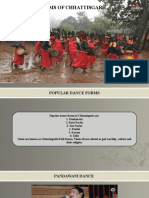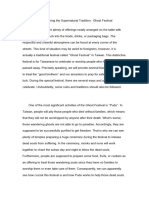Prehistoric Shiva Ratri
Prehistoric Shiva Ratri
Uploaded by
Mythili MuthappaCopyright:
Available Formats
Prehistoric Shiva Ratri
Prehistoric Shiva Ratri
Uploaded by
Mythili MuthappaOriginal Description:
Copyright
Available Formats
Share this document
Did you find this document useful?
Is this content inappropriate?
Copyright:
Available Formats
Prehistoric Shiva Ratri
Prehistoric Shiva Ratri
Uploaded by
Mythili MuthappaCopyright:
Available Formats
One of the prehistoric festivals of India is Shiva ratri, or night of Shiva.
In various forms. the deity Shiva may be traced clearly right through the early historic age to the Indus civilisation : further back in mesolithic carvings on walls. Some feel shiva as lord of the animals or the hunt , 0i1 .s reflected even as far ago as the paleolithic. For instance the cave paintings found in many places in the world. In the people s tradition the stories and legends of Shiva are very popular all over India. !hey often reflect folk memories of a happy food gathering way of life""" living in hill forests, going on sprees, dancing and the like, remembrances of a time before settled agriculture and civilisation #""as we define it$. !he festival of Shiva Shivaratri also signifies the end of winter and arrival of spring. %n the day of Shivaratri all over India, the observances are similar. In most villages and less so in towns, people get up earlier than usual, take a bath preferably in a river or lake. !hen they go to a shrine nearby, or at home set up a small linga which is &ust a small pillar. !his symbolises Siva the ancient deity. 'ow, although various interpretations have been aired, this is certainly a tribal fertility symbol, and represents the male generative organ, as even the rig veda mentions. 'o need to e(plain away obvious facts. )ll human ancestors were cheerful tribal people once. *esides most festivals in India are affirmations of 'ature anyway. The pooja, or service . !he farmers and their families commence the rituals #poo&a$ in the usual manner of sprinkling water, offering flowers, leaves, incense , wave pieces of burning camphor on a plate #this process is called aarati$, and so on while listening or repeating the formulae # mantras$. !hese are for the most part a collection in sanskrit of the titles of Siva, a type of inde( reference #pointers+$ to the legends which everyone gathered there already knows. )ctually few really understand the actual sanskrit, but the people s stories are popular and handed down the generations without editing or censoring.... whatever may be the hidden levels of meaning to people who can recogni,e the insights, they are highly interesting, humorous and entertaining and no doubt strike a deep chord, else would not have survived to this day. #ed--searching for good hyper links$. In the rituals, leaves of a forest tree Aegle marmelos ( bilva, maredu, wood apple) are used in the services. )fter the poo&a is over they observe a fast. #!his is a difference"" usually after services in India people have a feast$. Remain awake on the night of Shiva In the evening they generally go to a nearby temple where in the company of many others
they listen to recitals of the legends and their meanings. !hey are supposed to remain awake the whole night. #Similar observance is seen in Islam too.$ %ften the family visits a large temple "" the trip may take a few days. )t such places the crowds are huge. !here may be various temporary auditoria or stages erected all over the place. ) regular fair or market springs up. In olden days people used to buy things which weren t available in the remote villages. !oday the market aspect is not very important, but it affords a chance to see old traditional dances, drama and other performing arts which are disappearing. Straight out of 'ational -eographic, sort of. In )ndhra pradesh Siva temples are very important. It appears the ancient notions here was some form of saivism. !his is to be e(pected anyway since there is a still a strong tribal element : besides there is a strong egalitarian streak in the reform activities which appealed to the bulk of people as a whole. .veryone is allowed inside Shiva temples. .ven animals. For instance monkeys and bulls and dogs can roam inside shiva temples and no one will stop them. /oesn t 0uite fit into our modern notions of proper order and regulations and procedures, but from their reasoned point of view it makes sense. 1ou can t keep 'ature out of places affirming 'ature. Shrines to shiva are found all over India and if pagan culture is taken into account, fairly common all over the world. In )ndhra 2radesh, there are important centres like Srisailam, 3alahasti, 3alesvaram, 3eesara #close to 4yderabad$ and many others. Several are tourist centres. 5hile the places may be a bit crowded, people say the best time to visit them is during such festivals.
You might also like
- " Spirits of An Ancient Drama: Judy Slattum - Paul SchraubDocument132 pages" Spirits of An Ancient Drama: Judy Slattum - Paul SchraubCecilia IidaNo ratings yet
- 8 Cultural Practices of Harappan Era That Has Still Been Continued Till TodayDocument12 pages8 Cultural Practices of Harappan Era That Has Still Been Continued Till TodayRaqs-e- AdabNo ratings yet
- Art Research PaperDocument8 pagesArt Research PaperGladys SamaNo ratings yet
- "Khumb Mela" - India TRAVELDocument4 pages"Khumb Mela" - India TRAVELRegina BusseNo ratings yet
- ACTIVITY-SHEET in Contemporary Phil. Arts From The RegionsDocument16 pagesACTIVITY-SHEET in Contemporary Phil. Arts From The RegionsMaribel Nitor LopezNo ratings yet
- Contemporary Arts From The Region 2 Semester - 1 Quarter - : ND STDocument12 pagesContemporary Arts From The Region 2 Semester - 1 Quarter - : ND STRienalyn GalsimNo ratings yet
- Theyyam The Dance of Gods Cultural Beliefs in India Origin and ImplicationsDocument22 pagesTheyyam The Dance of Gods Cultural Beliefs in India Origin and Implicationszroro8803No ratings yet
- Ways To Shiva PDFDocument100 pagesWays To Shiva PDFAkshay ManveNo ratings yet
- Cult Mah PDFDocument83 pagesCult Mah PDFjoy parimalaNo ratings yet
- GI CHERIYAL Cluster DocumentDocument45 pagesGI CHERIYAL Cluster DocumentSmritiNo ratings yet
- Pictorial Writing #4 Festival - A New MorningDocument2 pagesPictorial Writing #4 Festival - A New MorningGeorgeNo ratings yet
- Shaiva Fairs and FestivalsDocument5 pagesShaiva Fairs and Festivalsसंदीप द्विवेदीNo ratings yet
- The City of ShivaDocument6 pagesThe City of Shivaसंदीप द्विवेदीNo ratings yet
- MooyDocument3 pagesMooyMiko Jane EstemberNo ratings yet
- Week 1 Module 1 Contemporary ArtsDocument26 pagesWeek 1 Module 1 Contemporary ArtsCamille Joves Encarnacion100% (2)
- SubliDocument2 pagesSubliken91% (11)
- Course 211 Drama, Dance & Folk ArtDocument32 pagesCourse 211 Drama, Dance & Folk ArtNamita SahareNo ratings yet
- Kadayawan Festival/ Pahiyas Festival: Group 4Document12 pagesKadayawan Festival/ Pahiyas Festival: Group 4garry nunezNo ratings yet
- Celebrating Life Indian FestivalsDocument21 pagesCelebrating Life Indian FestivalsRohan WorkNo ratings yet
- The Evolution of Philippine Art: Pre-ConquestDocument65 pagesThe Evolution of Philippine Art: Pre-ConquestMiggy Marie SullvanyahNo ratings yet
- Where can buy Chinese Folk ARTS 1ST Edition Jin Zhilin ebook with cheap priceDocument52 pagesWhere can buy Chinese Folk ARTS 1ST Edition Jin Zhilin ebook with cheap pricesetinatarot100% (1)
- N A P C: P: A Member of The Plains Cree TribeDocument3 pagesN A P C: P: A Member of The Plains Cree TribeOscar Panez LizargaNo ratings yet
- JambudvipaDocument4 pagesJambudvipakrish8717No ratings yet
- Module 1Document28 pagesModule 1Bhong Vicencio BacaltosNo ratings yet
- Module-1Document28 pagesModule-1Fernandez, Nadine Kate T.No ratings yet
- LeapLinksContemporaryWeek1-2Document4 pagesLeapLinksContemporaryWeek1-2MabelGuillemerNo ratings yet
- Culture of PunjabDocument13 pagesCulture of Punjabjattsidhu1988100% (1)
- Dance Forms of ChhattisgarhDocument10 pagesDance Forms of ChhattisgarhNishant Jha100% (1)
- The Girija Kalyana Story: HampiDocument4 pagesThe Girija Kalyana Story: Hampianand_kpmNo ratings yet
- Phil Pre-Colonial Art by ORIGENESDocument7 pagesPhil Pre-Colonial Art by ORIGENESDominique OrigenesNo ratings yet
- Warli ArtDocument9 pagesWarli Artlubna_rahman2002No ratings yet
- BeadsDocument19 pagesBeadsdroidynNo ratings yet
- Conarts 2Document4 pagesConarts 2Danielle MerlinNo ratings yet
- Indigenous ArtDocument17 pagesIndigenous ArtLeigh JohnsonNo ratings yet
- VKIC Newsletter - April 15 - September-15Document8 pagesVKIC Newsletter - April 15 - September-15Vivekananda Kendra Institute of CultureNo ratings yet
- Philippine Art Before ColonizationDocument13 pagesPhilippine Art Before ColonizationMthw Mathew50% (2)
- A Brief Analysis About Folklore Culture of Karnataka Ijariie19565Document6 pagesA Brief Analysis About Folklore Culture of Karnataka Ijariie19565suryaprabhahosamani99No ratings yet
- Sindhi FoodDocument93 pagesSindhi FoodSunil Kumar100% (1)
- Dhyanksy IndusValleyOriginYogaPracticeDocument21 pagesDhyanksy IndusValleyOriginYogaPracticeCharlie Higgins100% (1)
- The Indus Valley Origin of A Yoga PracticeDocument21 pagesThe Indus Valley Origin of A Yoga Practicevaibhav thakorNo ratings yet
- The Chinese Festivals - Ancient China Life, Myth and Art | Children's Ancient HistoryFrom EverandThe Chinese Festivals - Ancient China Life, Myth and Art | Children's Ancient HistoryNo ratings yet
- ArtsDocument7 pagesArtsSunseth LerienNo ratings yet
- Hagabi: An Ifugao LuxuryDocument2 pagesHagabi: An Ifugao LuxuryPatricia Kamille I. PawidNo ratings yet
- Dhyanksy IndusValleyOriginYogaPractice PDFDocument21 pagesDhyanksy IndusValleyOriginYogaPractice PDFkellybrandNo ratings yet
- Ghost FestivalDocument2 pagesGhost Festivalweicheng930616No ratings yet
- MastiDocument1 pageMastiRajendra KshetriNo ratings yet
- Maha ShivratriDocument12 pagesMaha Shivratrivrohit308No ratings yet
- (Indian Literature 1994-Jul-Aug Vol. 37 Iss. 4 (162) ) Ramanujan - WHO NEEDS FOLKLORE - Ramanujan On FolkloreDocument15 pages(Indian Literature 1994-Jul-Aug Vol. 37 Iss. 4 (162) ) Ramanujan - WHO NEEDS FOLKLORE - Ramanujan On FolkloreBernadett SmidNo ratings yet
- Bastar Dusshera A Unique Tribal FestivalDocument5 pagesBastar Dusshera A Unique Tribal FestivalRona BaeNo ratings yet
- Contemporary Arts in The Philippines: PrehistoricDocument61 pagesContemporary Arts in The Philippines: PrehistoricRussel AloceljaNo ratings yet
- Islamic Religion and Ancestral Beliefs in Kasepuhan Ciptagelar (Kelas F)Document7 pagesIslamic Religion and Ancestral Beliefs in Kasepuhan Ciptagelar (Kelas F)elmo azzamNo ratings yet
- SRI LANKA Vesak - A Thrice Blessed AnniversaryDocument4 pagesSRI LANKA Vesak - A Thrice Blessed AnniversaryThavam RatnaNo ratings yet
- Arts Education Fourth QuarterDocument10 pagesArts Education Fourth QuarterseengulariteaNo ratings yet
- Chorok PujaDocument11 pagesChorok PujaMashfique AhmedNo ratings yet
- RURALS-2020: Socio-Cultural and Public AdmisnistrationDocument94 pagesRURALS-2020: Socio-Cultural and Public AdmisnistrationLuckshaya AnandNo ratings yet
- RPH NotesDocument3 pagesRPH NotesSTEM - Mike Lowin SulianoNo ratings yet
- A Market Survey On Eastern Curry Powder With Special Reference To Coimbatore CityDocument5 pagesA Market Survey On Eastern Curry Powder With Special Reference To Coimbatore CityMythili Muthappa0% (1)
- TdsIncome Tax ActDocument61 pagesTdsIncome Tax ActMythili MuthappaNo ratings yet
- Retail BrandingDocument84 pagesRetail BrandingMythili MuthappaNo ratings yet
- ConceptualDocument3 pagesConceptualMythili MuthappaNo ratings yet
- Customer Satisfaction of Bajaj AllianzDocument62 pagesCustomer Satisfaction of Bajaj AllianzMythili MuthappaNo ratings yet
- Infosys BSE: 500209 - NSE: INFY - ISIN: INE009A01021 Date Open High Low CloseDocument22 pagesInfosys BSE: 500209 - NSE: INFY - ISIN: INE009A01021 Date Open High Low CloseMythili MuthappaNo ratings yet
- UL Questionnaire v.2Document9 pagesUL Questionnaire v.2Mythili MuthappaNo ratings yet
- Session 7. Renewables and Waste - Yasmina Abdelilah International Energy Agency NEW For The WEBSITEDocument42 pagesSession 7. Renewables and Waste - Yasmina Abdelilah International Energy Agency NEW For The WEBSITEMythili MuthappaNo ratings yet
- Chapter-1: A Study On Spare Parts Management at HLLDocument67 pagesChapter-1: A Study On Spare Parts Management at HLLMythili MuthappaNo ratings yet
- Satisfaction Level at Different CFS and Rail OperationsDocument67 pagesSatisfaction Level at Different CFS and Rail OperationsMythili MuthappaNo ratings yet
- A Study On Team Work and Employee InvolvementDocument14 pagesA Study On Team Work and Employee InvolvementMythili MuthappaNo ratings yet
- Big Data: Go Big or Go Home?Document19 pagesBig Data: Go Big or Go Home?Mythili MuthappaNo ratings yet
- Seminar - PPT - FinalDocument26 pagesSeminar - PPT - FinalMythili MuthappaNo ratings yet
- PDD ABIL 10sep2003Document54 pagesPDD ABIL 10sep2003Mythili MuthappaNo ratings yet
- Prospects of Mountaineering and Trekking Tourism in NepalDocument32 pagesProspects of Mountaineering and Trekking Tourism in NepalMythili MuthappaNo ratings yet
- ThiruvasagamDocument113 pagesThiruvasagamMythili MuthappaNo ratings yet
- Prehistoric Shiva RatriDocument2 pagesPrehistoric Shiva RatriMythili MuthappaNo ratings yet












































































